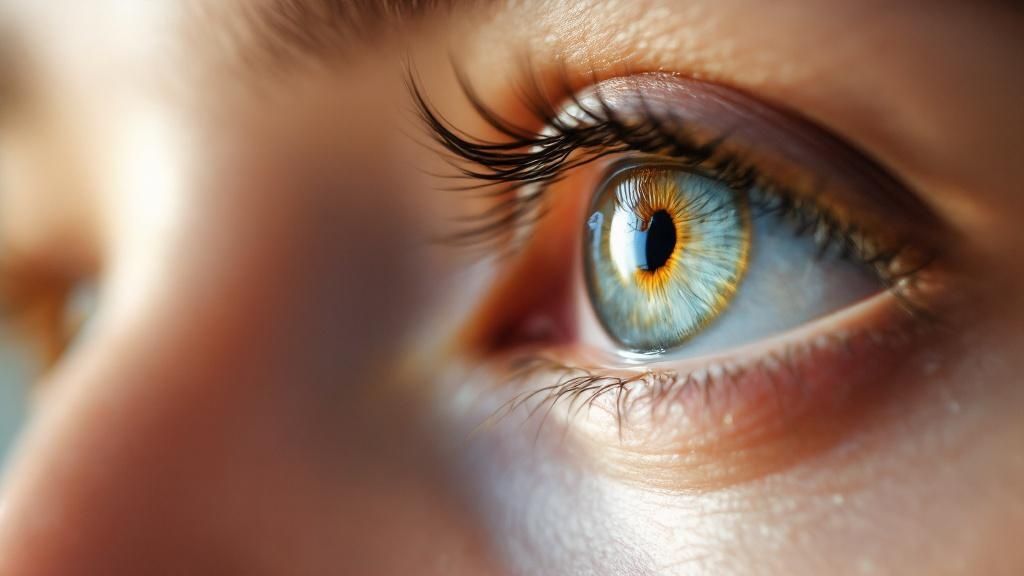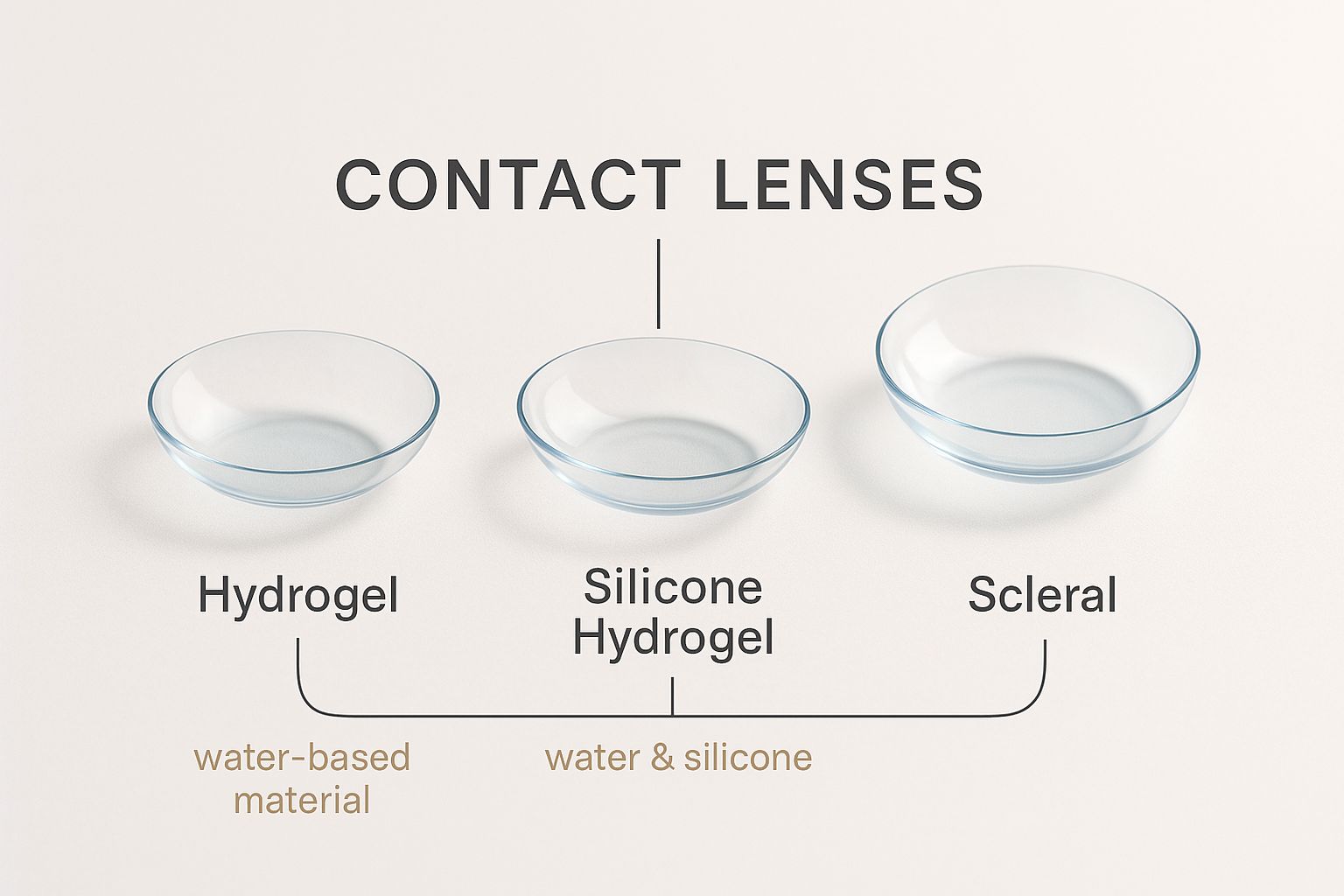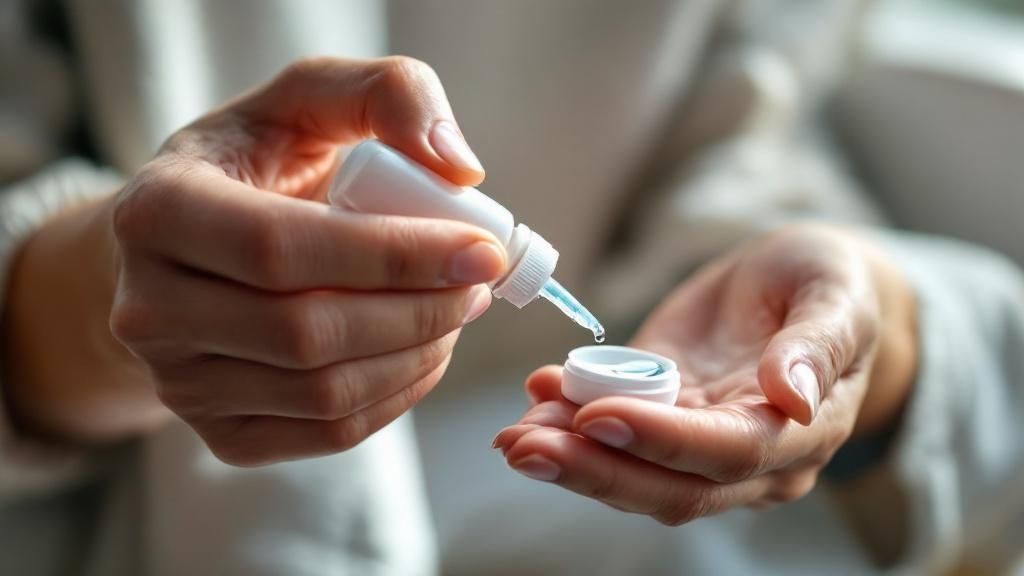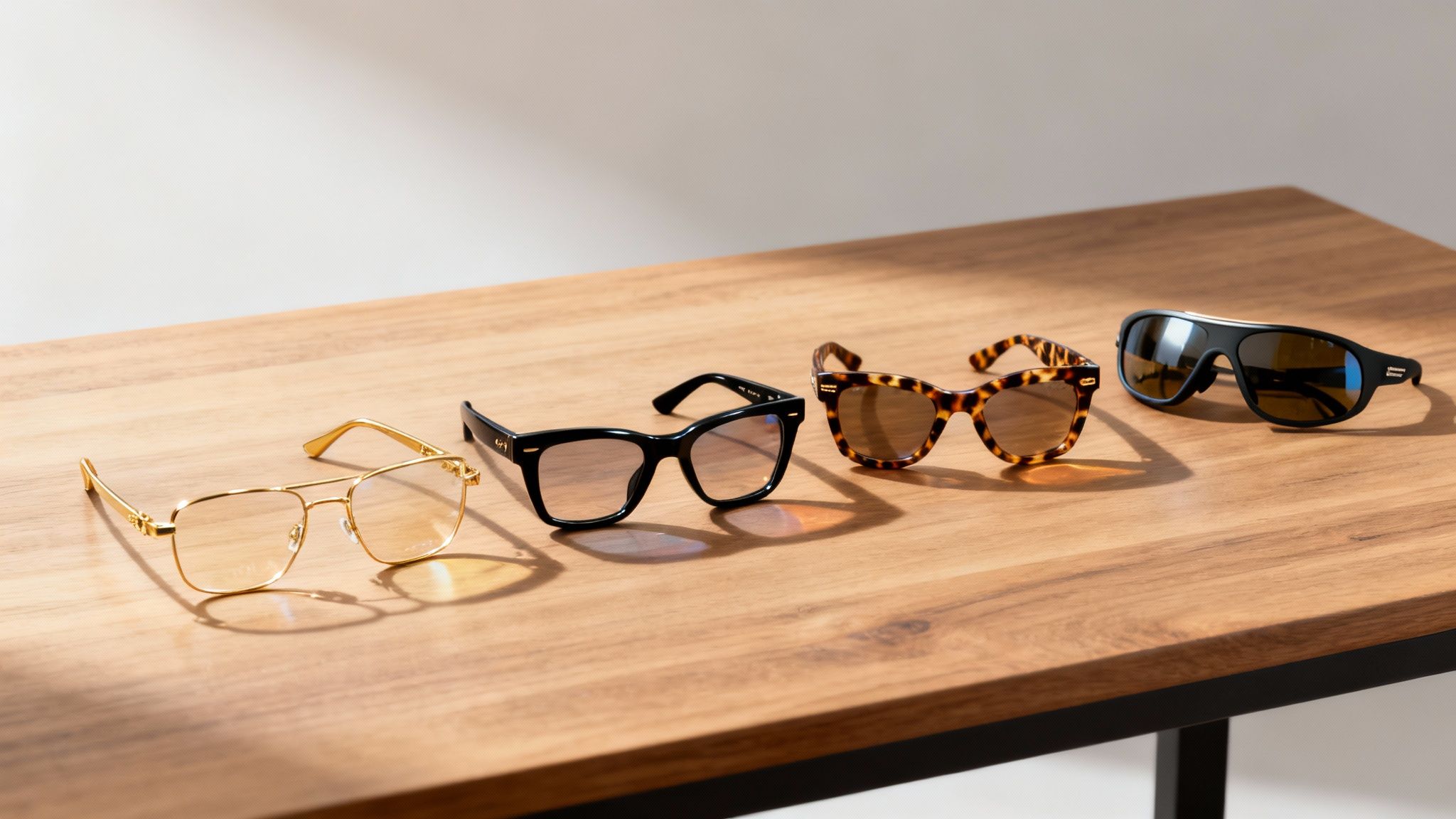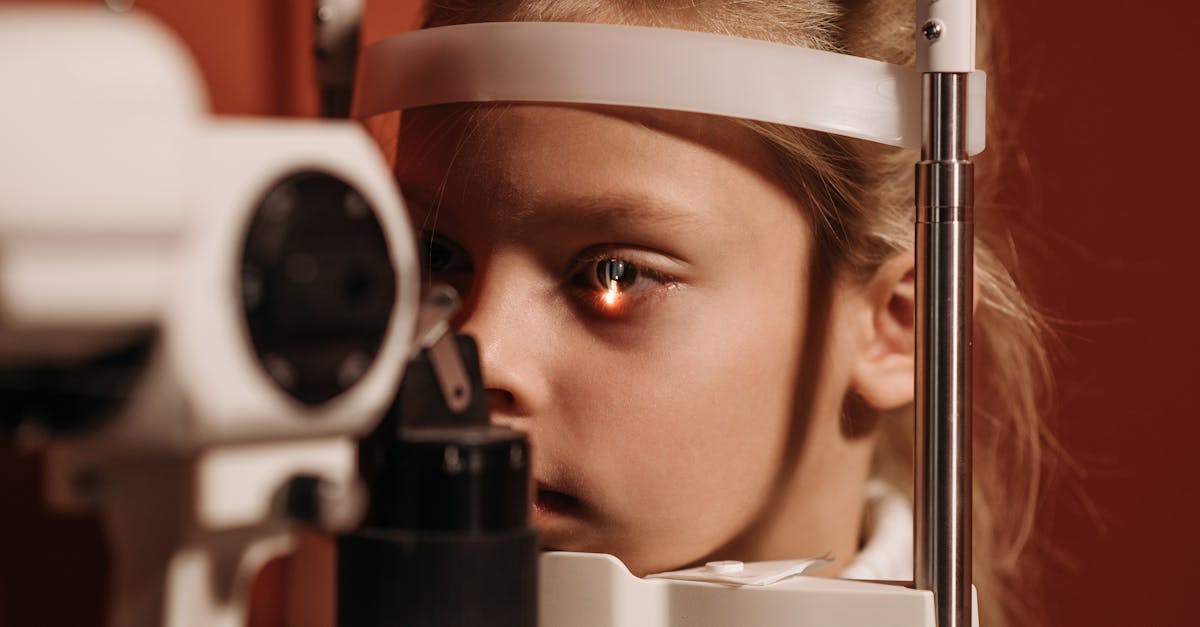If you’ve ever felt that gritty, sandpaper-like irritation from wearing contacts with dry eyes, you know how frustrating it can be. It often feels like you have to choose between clear vision and comfort. But what if you didn't have to? For residents of Glendale Heights and the surrounding suburbs, the good news is, you don't.
The best contacts for dry eyes are usually daily disposable lenses crafted from advanced materials like silicone hydrogel. These aren't your old-school contacts; they're specifically engineered by brands like Acuvue, Alcon, and CooperVision to keep your eyes feeling moist and healthy all day long. At iDoctor, our mission is to find the perfect solution for your lifestyle.
Your Guide to Comfortable Vision with Dry Eyes
Living with dry eyes here in Glendale Heights can be a real challenge. That constant tired, gritty sensation shouldn't mean giving up the freedom that contact lenses offer. Think of this guide as your roadmap to finding comfortable, clear vision that takes you from your morning coffee all the way through your evening unwind.
We’re going to pull back the curtain on why some contacts make dryness worse and introduce you to the amazing lens technologies designed to fix that very problem. We'll break down the science of lens materials and moisture-retaining tech in a way that actually makes sense. Here at iDoctor, our goal is to find a solution that fits seamlessly into your life, whether you’re navigating a busy day at Glendale Lakes Business Park or enjoying a quiet weekend.
What You Will Discover
We'll walk through everything you need to know to make a smart choice for your eyes, focusing on a few key areas to get you on the path to lasting relief.
- The Root Cause: First, we’ll dig into why certain contact lenses can interfere with your eye's natural moisture, causing that familiar discomfort.
- Modern Materials: You'll get to know next-generation materials like silicone hydrogels, which are game-changers for breathability and hydration.
- Top Technologies: We'll spotlight the specific brands and moisture-locking features that have been a big hit with our Glendale Heights patients.
- The Perfect Fit: We’ll explain why a professional fitting isn't just a suggestion—it's the single most important step to making sure your lenses feel great.
At iDoctor, we firmly believe that exceptional vision shouldn't compromise comfort. A professional contact lens fitting is where it all comes together—marrying precise measurements from our high-resolution imaging with a real understanding of your daily life to find that perfect match.
Let's start by looking at why your current lenses might be part of the problem. From there, we’ll jump into the exciting solutions we have waiting for you at our Glendale Heights boutique. Your journey to comfortable, clear vision starts now.
Why Your Contacts Can Make Dry Eyes Feel Worse
If you wear contacts, you probably know the feeling. Your vision is sharp when you pop your lenses in, but by the time you’re heading home on Bloomingdale Road, your eyes are gritty, tired, and just plain dry. It’s an incredibly common complaint, but what’s actually happening on the surface of your eye?
Think of your natural tear film as a perfectly balanced, three-layer coating that keeps your eyes hydrated and protected. A contact lens is a foreign body that sits right on top of this delicate ecosystem. The problem is, some lenses—especially older designs—can act like tiny sponges, soaking up the moisture your eye desperately needs to stay comfortable.
This sponge effect throws the entire system off balance. Your tears start to evaporate faster than your eye can produce them, and that's when the irritation kicks in. Your eye is suddenly working overtime trying to hydrate both itself and the lens, and it just can't keep up.
The Science of Tear Film Disruption
Your tear film is a lot more complex than just salty water, and it doesn't take much to disturb it. A contact lens can interfere in a few specific ways:
- Moisture Absorption: Certain lens materials are naturally "thirsty" and pull moisture directly from your cornea to keep themselves hydrated. This is a direct drain on your eye's natural moisture.
- Reduced Oxygen: Lenses create a barrier that can limit how much oxygen gets to your cornea. A well-oxygenated eye is a comfortable eye, so this can be a big source of irritation.
- Improper Fit: If a lens doesn't perfectly match the curve of your eye, it can shift around with every blink. This movement constantly smears and disrupts the even layer of tears, preventing it from doing its job.
That nagging dry feeling isn't just in your head. It's a real, physical response to the lens getting in the way of your eye's protective moisture layer. It’s also why a "one-size-fits-all" approach to contacts rarely works for people with dry eye tendencies.
Dry eye disease (DED) is already a widespread issue, affecting an estimated 11.59% of people across the globe. When you introduce a contact lens to an already dry eye, it’s like pouring fuel on a fire. You can read more research on global dry eye prevalence to see just how common this condition is.
Local Factors That Add to the Problem
Living here in the Chicagoland area can add another layer of difficulty. The dry, cranked-up indoor heat during our long winters is notorious for zapping moisture from the air—and your eyes. Then, in the spring, the high pollen count can make things even worse. For a contact lens wearer, these environmental triggers can turn minor dryness into a daily battle.
Getting a handle on this fundamental conflict—the lens vs. your eye's natural state—is the first real step toward finding relief. It arms you with the right knowledge for a much better conversation with an eye doctor in Glendale Heights. They can help diagnose the root cause of your discomfort and find the best contacts for dry eyes that work with your eyes, not against them.
How Modern Lens Materials Are Built for Moisture
Not too long ago, contact lens technology was pretty basic. Most lenses were made from the same kind of material, which meant if you had dry eyes, you were often out of luck. It was a "one-size-fits-all" world, and it just didn't fit a lot of people comfortably.
Thankfully, things have changed dramatically. Today’s lenses are engineered with incredible precision to work with your eye's natural moisture, not against it. To really appreciate this leap forward, you have to understand the two main types of soft contact lens materials.
Traditional Hydrogel vs. The Silicone Hydrogel Breakthrough
The old-school material is called hydrogel. As the name implies, it’s a water-loving plastic polymer that can hold a lot of moisture. On the surface, that sounds perfect for dry eyes, right? The problem is, it can be a double-edged sword. If the lens itself starts to dry out over the course of the day, it can act like a tiny sponge and actually pull moisture from your tear film to stay hydrated, leaving your eyes even drier.
The real game-changer for anyone struggling with contact lens-related dryness has been silicone hydrogel. This advanced material weaves silicone into the traditional hydrogel structure, and that small change makes a world of difference.
Think of it this way: a traditional hydrogel lens is like a solid raincoat, but a silicone hydrogel lens is like a high-tech raincoat with breathable mesh panels. It lets the air flow.
Why does that matter? Oxygen. Silicone is incredibly permeable to oxygen, much more so than water. In fact, some modern silicone hydrogel lenses allow up to five times more oxygen to reach the cornea than their traditional hydrogel counterparts. A well-oxygenated eye is a healthier eye, which directly translates to less irritation and more comfort, especially if you’re prone to dryness.
This image highlights how different lens materials and types factor into a comfortable wearing experience.
As you can see, the evolution of lens technology gives us far better options for tackling dryness than ever before.
Comparing Contact Lens Materials for Dry Eyes
To make it clearer, let's break down the key differences between these two materials.
| Feature | Traditional Hydrogel Lenses | Silicone Hydrogel Lenses |
|---|---|---|
| Primary Material | Water-loving plastic polymer | A blend of silicone and hydrogel polymers |
| Oxygen Permeability | Lower; oxygen is transported through the water in the lens | Much higher; allows up to 5x more oxygen to the cornea |
| Moisture Mechanism | Relies on its own water content, may dry out the eye | Often includes built-in wetting agents for sustained moisture |
| Best For | Some daily disposables, wearers without significant dryness | Extended wear, people with dry or sensitive eyes |
Ultimately, the choice comes down to prioritizing oxygen and sustained hydration, which is where silicone hydrogel truly shines for those with dry eyes.
It's Not Just the Material—It's the Tech Inside
Top contact lens manufacturers don't just stop with a better base material. They integrate proprietary moisture technologies directly into the lens. These aren't just simple surface coatings; they are sophisticated systems designed to keep your eyes feeling fresh all day long.
While they all have unique brand names, most of this technology works in one of two ways:
- Embedded Wetting Agents: Imagine the lens material is infused with tiny, slow-release moisture beads. Every time you blink, these agents are gradually released, constantly refreshing the lens surface and supplementing your natural tear film.
- Water Gradient Technology: This is a seriously impressive innovation. Instead of having uniform water content, the lens is engineered in layers. The core has lower water content to maximize that all-important oxygen flow, while the outermost surfaces approach nearly 100% water. This creates an incredibly soft, silky cushion of moisture that's the only part of the lens that actually touches your eye.
Knowing this terminology helps you have a much more productive conversation with your eye doctor. When you come to iDoctor to discuss your options, understanding the difference between a basic hydrogel and a silicone hydrogel with water gradient technology empowers you to be an active partner in finding your perfect fit.
Of course, even the best lens won't feel good without proper care. For more on this, check out our expert tips for preventing common contact lens infections. Our team is here to walk you through all the options, translating these technical details into what matters most: real-world comfort.
Top Lens Technologies That Combat Dryness
Knowing the science behind lens materials is a great starting point, but what really matters is how that science translates into real-world comfort. Over the years, we've seen certain brands and their unique technologies bring incredible relief to our patients who thought they'd have to give up on contacts for good. These aren't just minor tweaks; they're genuine breakthroughs in all-day hydration.
Let's walk through some of the go-to options that have proven to be game-changers for people right here in Glendale Heights. These lenses are engineered from the ground up to be powerful allies against dryness, each taking a slightly different but highly effective approach to keeping your eyes feeling fresh.
Leading Brands and Their Moisture-Locking Innovations
When you start looking for the best contacts to combat dryness, you'll see a few names pop up again and again. That's no accident. Brands like Johnson & Johnson, Alcon, and CooperVision have poured immense resources into developing features that you can actually feel from the moment you put the lens in.
Here are a few of the technologies we frequently recommend and why they work so well:
- Acuvue Oasys with HydraLuxe Technology: This isn't some simple surface coating. HydraLuxe technology weaves a network of tear-like molecules right into the fabric of the lens material. The whole point is for the lens to work in harmony with your natural tear film, helping keep it stable and warding off that tired, gritty feeling as the day wears on.
- Alcon Dailies Total1: This lens is a classic for a reason. It uses a brilliant concept called Water Gradient Technology. The inside of the lens is a silicone hydrogel that lets plenty of oxygen through, but the outer surface—the part that actually touches your eye—is a cushion of moisture that's nearly 100% water. This creates an unbelievably smooth, silky feeling that drastically reduces friction with every blink.
- CooperVision MyDay: These daily disposables feature what CooperVision calls Smart Silicone™ chemistry. It’s a more efficient way to build a lens, using less raw silicone to achieve incredibly high oxygen flow. This results in a lens that’s not only super breathable but also noticeably softer and more flexible, with built-in channels that lock in moisture.
An easy way to think about it is that older lenses were like sponges—they just held water until it evaporated. These modern lenses, however, are like tiny irrigation systems, actively managing and integrating with your eye's natural moisture. This shift from passive hydration to active support is what makes all the difference for dry eye sufferers.
What This Means for Your Eyes
When you choose a lens with one of these advanced features, you’re getting so much more than just vision correction. You're getting a tiny, sophisticated piece of tech designed specifically to fight that irritating, scratchy sensation that can completely derail your day. Ultimately, the goal is to make you forget you're even wearing contacts.
For example, that "cushion of moisture" from Dailies Total1 is a lifesaver for anyone who stares at a computer all day, since it helps make up for the fact that we blink less when focused on a screen. In the same way, the tear-mimicking molecules in Acuvue Oasys can be a huge help during allergy season or in the dry, whipping winter air we get here in Chicagoland.
Figuring out which technology is right for you is a crucial part of the process. During a contact lens fitting in Glendale Heights, we can talk through your specific symptoms and lifestyle to see which of these might be the best fit. To learn even more, you can check out our in-depth guide to the best contact lenses for dry eyes. Finding the right technology is the first step toward finally getting clear, comfortable, and irritation-free vision.
Why a Professional Fitting Is Non-Negotiable
Picking a contact lens based on its fancy marketing name is a lot like buying running shoes just because you like the color. They might look great, but that says nothing about the fit, the support, or how they'll actually perform when you put them to the test. Finding the right contacts for dry eyes is a medical fitting process, not a simple retail purchase.
An ill-fitting lens, no matter how advanced its moisture technology, can make your symptoms so much worse. It can destabilize your tear film with every single blink and even restrict the vital flow of oxygen to your cornea. This is exactly why a professional fitting with the best optometrist in Glendale Heights is the most important step you can possibly take.
This process is about so much more than just getting your prescription right. It’s about making sure your vision is not only sharp but also comfortable and healthy for the long run, especially when dealing with a persistent condition like dry eye.
What Happens During a Contact Lens Fitting
A proper fitting goes way beyond the numbers on your glasses prescription. It’s a deep dive into the unique anatomy and health of your eyes. At iDoctor, our process is meticulous because we’ve seen firsthand how those tiny details are what separate all-day comfort from constant irritation.
During your visit, we’ll focus on several key measurements:
- Corneal Curvature: We use a keratometer to measure the exact curve of your cornea. This is what determines the "base curve" of the lens, ensuring it sits smoothly on your eye instead of being too tight or too loose.
- Corneal Diameter: We also measure the size of your cornea to select a lens diameter that provides complete, comfortable coverage without moving around too much.
- Tear Film Evaluation: This is a big one. We carefully assess the quality and stability of your tear film to see if there are underlying issues contributing to the dryness. This helps us choose a lens material that will work with your natural tears, not against them.
A professional fitting is the difference between guessing what might work and knowing what will. It replaces the uncertainty of online shopping with the precision of medical expertise, ensuring the lens you wear is perfectly matched to your eye's shape and health needs.
The iDoctor Difference in Glendale Heights
It’s a staggering number, but in the United States, nearly 16 million people have been diagnosed with dry eye disease. A huge portion of these cases are tied to Meibomian gland dysfunction (MGD), which is a problem with the tiny oil glands in your eyelids. This research really highlights the complexity of the condition, and that complexity demands a precise, well-informed approach.
Our 30-minute detailed eye exams in Glendale Heights and high-resolution imaging give us the hard data we need to make an expert recommendation. We don’t just hand you a popular brand; we find the specific lens that will give your eyes the best possible moisture retention and breathability. Learn more about our approach to a personalized contact lens fitting in Glendale Heights and see how our boutique level of care can make all the difference in your daily comfort.
Daily Habits to Maximize Your Lens Comfort
Choosing the right lens technology is a huge first step, but it's your daily habits that really seal the deal for comfortable wear. Making small, consistent tweaks to your routine can have a massive impact on how your eyes feel day-to-day, especially when that familiar dryness starts to creep in.
Think of it this way: you’ve already invested in high-quality lenses for your eye health. Now, it's about supporting that investment. Even the best contacts for dry eyes can only do so much without the right backup from smart, moisture-friendly routines.
Start with Smart Hygiene
Good hygiene isn't just a suggestion—it's the bedrock of safe and comfortable lens wear. Always, always wash your hands before you touch your lenses, and stick to the cleaning routine your optometrist gave you.
- Rub and Rinse: Don't just top off the solution in your case. That’s a recipe for trouble. Use fresh solution every single time, and gently rub each lens in your palm to physically break up stubborn protein deposits that soaking alone can't touch.
- Case Care: Your contact lens case isn't meant to last forever. Toss it and get a new one at least every three months to keep nasty bacteria from setting up shop.
If you need a quick refresher on the basics, our guide on how to properly insert your contact lenses is packed with helpful tips.
Adapt to Your Environment
Your surroundings have a much bigger say in your eye comfort than you might think. Being mindful of your environment—whether you're at home, at work, or just out and about in Glendale Heights—can make a world of difference.
The 20-20-20 rule is a game-changer for anyone glued to a screen. Every 20 minutes, look away at something about 20 feet in the distance for at least 20 seconds. It’s a simple trick that gives your eye muscles a break and reminds you to blink, which naturally re-wets your eyes.
This is more important than ever, as we're seeing dry eye syndrome pop up in younger people. Hours of screen time mean we blink less, and the research backs this up. Some studies show prevalence rates hitting over 50% in university students, largely due to intense screen use. If you're curious about the science, you can discover more insights about these findings.
Little changes can help, too. Fire up a humidifier during our dry Illinois winters to put some moisture back into the air. If you're heading somewhere windy like Camera Park, pop on some sunglasses to shield your eyes from drying gusts. Creating a more eye-friendly environment lets your advanced contacts do their job without having to battle the elements.
FAQs About Contacts for Dry Eyes in Glendale Heights
If you're dealing with dry eyes but want to wear contacts, you probably have a lot of questions. It's a common conversation we have with our patients here in Glendale Heights, so let's walk through some of the biggest ones.
Are daily disposable contacts a good choice for dry eyes?
Yes, they're often the first thing we recommend. When you start with a brand new, perfectly clean lens every morning, you completely sidestep the daily buildup of proteins and other deposits that can really irritate a dry eye. Plus, many of today's best daily disposables are made from incredibly advanced materials designed specifically for high moisture and breathability. We can determine if dailies are the right move for you during a contact lens fitting in Glendale Heights.
Can I just use any eye drops with my contacts?
This is a critical one: absolutely not. You need to be very selective and only use rewetting drops that are explicitly marked as "for use with contact lenses." Regular over-the-counter dry eye drops can actually stick to the lens material, creating a cloudy film that blurs your vision and makes irritation worse. Our optometrists can recommend the best and safest drops for your specific lenses. For more advanced solutions, you can learn about our other top dry eye treatment options.
Does iDoctor sell designer eyewear brands like Gucci?
Yes, we do. In addition to providing the best contact lenses in Glendale Heights, our boutique offers a curated collection of luxury and affordable eyewear. You can find top brands like Gucci, Cartier, Tom Ford, and Prada, as well as popular choices like Ray-Ban and Coach. Whether you need designer eyeglasses in Glendale Heights or a new pair of sunglasses, we have something for every style.
Does iDoctor take my vision insurance for contact lenses?
Of course. We are proud to accept all major vision insurance plans at our Glendale Heights boutique. Our knowledgeable team is here to help you navigate and maximize your benefits, covering everything from your comprehensive eye exam to your yearly supply of contact lenses.
Don't let dry eyes dictate your vision choices. The right contact lenses can offer both clarity and all-day comfort. If you're near North Avenue or President Street, stop by our Glendale Heights boutique to explore your options. Schedule your detailed eye exams in Glendale Heights at iDoctor today and experience the difference that personalized, expert care can make.


